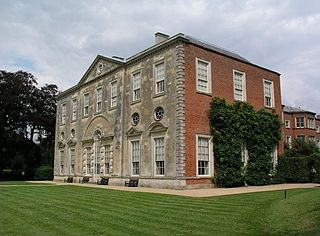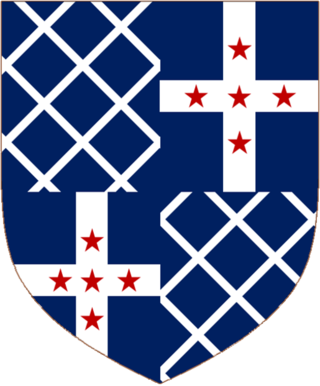Duke of Buckingham, referring to Buckingham, is an extinct title that has been created several times in the peerages of England, Great Britain, and the United Kingdom. There were creations of double dukedoms of Buckingham and Normanby and of Buckingham and Chandos. The last holder of the dukedom died in 1889.

Claydon House is a country house in the Aylesbury Vale, Buckinghamshire, England, near the village of Middle Claydon. It was built between 1757 and 1771 and is now owned by the National Trust.

Viscount Cobham is a title in the Peerage of Great Britain that was created in 1718. Owing to its special remainder, the title has passed through several families. Since 1889, it has been held by members of the Lyttelton family.

Baron Braye, of Eaton Bray in the County of Bedford, is a title in the Peerage of England. It was created in 1529 for Edmund Braye, 1st Baron Braye. However, the family originally originate from Normandy, they are direct descendants of Chevalier Baudry de Bray who came over to England in the Battle of Hastings of 1066. The family's local area in Leicestershire played host to two battles in England of note, the Battle of Bosworth Field where the current family's ancestor's were on opposing sides, and also Battle of Naseby during the First English Civil War, where the old manor house hosted King Charles I. The barony was created by writ, which means that it can descend through both male and female lines. He was succeeded by his son, the second Baron. He died from wounds received at the Battle of St Quentin in 1557. Lord Braye was childless and on his death the title fell into abeyance between his sisters.

Baron Stafford, referring to the town of Stafford, is a title that has been created several times in the Peerage of England. In the 14th century, the barons of the first creation were made earls. Those of the fifth creation, in the 17th century, became first viscounts and then earls. Since 1913, the title has been held by the Fitzherbert family.

Earl of Rosse is a title that has been created twice in the Peerage of Ireland, both times for the Parsons family. "Rosse" refers to New Ross in County Wexford.

The Verney family purchased the manor of Middle Claydon in Buckinghamshire, England, in the 1460s and still resides there today at the manor house known as Claydon House. This family had been seated previously at Fleetmarston in Buckinghamshire then at Pendley in Hertfordshire. It is not to be confused with the unrelated but also ancient and prominent Verney family of Compton Verney in Warwickshire.

Earl of Bellomont, in the Kingdom of Ireland, was a title that was created three times in the Peerage of Ireland. The first creation came on 9 December 1680 when Charles Kirkhoven, 1st Baron Wotton, was made Earl of Bellomont. He had already been created Baron Wotton, of Wotton in the County of Kent, in the Peerage of England on 31 August 1650. He was childless and both titles became extinct on his death in 1683.

Baron Wentworth is a title in the Peerage of England. It was created in 1529 for Thomas Wentworth, who was also de jure sixth Baron le Despencer of the 1387 creation. The title was created by writ, which means that it can descend via female lines.
Viscount Langford, of Longford Lodge, was a title in the Peerage of Ireland. It was created on 19 February 1766 for Elizabeth Rowley. She was made Baroness of Summerhill at the same time, also in the Peerage of Ireland. She was the wife of Hercules Langford Rowley, a member of the Irish Privy Council, grandson of Sir John Rowley and Mary, daughter of Sir Hercules Langford, 1st Baronet. She was succeeded by her son, the second Viscount. He represented County Antrim and Downpatrick in the Irish Parliament. The title became extinct in 1796 on the death of the second Viscount. The Rowley estates were inherited by Clotworthy Taylor, fourth son of Thomas Taylor, 1st Earl of Bective by his wife Jane, daughter of Hercules Langford Rowley and the Viscountess Langford. He assumed by Royal licence the surname of Rowley in 1796 and in 1800 the Langford title was revived when he was raised to the Peerage of Ireland as Baron Langford. This title is still extant.
Viscount Wenman, of Tuam in the County of Galway, was a title in the Peerage of Ireland. It was created on 30 July 1628 for Sir Richard Wenman, Member of Parliament for Oxfordshire in 1620 and 1625, the son of Thomas Wenman, a Buckinghamshire landowner. He was made Baron Wenman, of Kilmaynham in the County of Meath, at the same time, also in the Peerage of Ireland. He was succeeded by his son, the second Viscount. He represented Brackley and Oxfordshire in Parliament. On his death the titles passed to his younger brother, the third Viscount. After the death of his childless only son, he obtained a new patent in 1683, with remainder to his great-nephew, Sir Richard Wenman, 2nd Baronet, with the precedence of 1628. The latter succeeded as fourth Viscount according to the new patent in 1686. He had earlier represented Brackley in Parliament. His grandson, the sixth Viscount, represented Oxford in the House of Commons. On the latter's death the titles passed to his son, the seventh Viscount. He sat as Member of Parliament for Oxfordshire for many years. The titles became extinct on his death in 1800. As all the peerage titles were in the Peerage of Ireland, the Viscounts did not have the right to sit in the British House of Lords.

Sir Ralph Verney, 1st Baronet DL, JP was an English baronet and politician who sat in the House of Commons at various times between 1640 and 1690.

John Verney, 1st Viscount Fermanagh, known as Sir John Verney, 2nd Baronet, between 1696 and 1703, was an English peer, merchant and Tory politician who sat in the House of Commons from 1710 to 1717.
There have been three baronetcies created for members of the Gore family, all in the Baronetage of Ireland. All three titles are extant. The family also holds two earldoms and a barony.

Assheton Curzon, 1st Viscount Curzon, styled Lord Curzon between 1794 and 1802, was a British Tory politician.
Ralph Verney may refer to:

Ralph Verney, 2nd Earl Verney PC, FRS, was a member of the Verney family of Middle Claydon and a British politician.
Ralph Verney, 1st Earl Verney, of Middle Claydon, near Buckingham, Buckinghamshire, known as The Viscount Fermanagh until 1742, was initially a Tory and later a Whig politician who sat in the House of Commons in two phases between 1717 and 1752.

Mary Verney was the wife of Sir Ralph Verney, 1st Baronet, of Middle Claydon DL, JP (1613–1696), an English baronet and politician who sat in the House of Commons.
Hercules Langford Rowley PC was an Irish politician and landowner.













